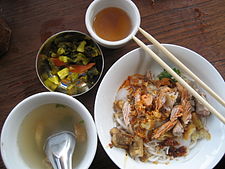Meeshay
Meeshay, (Template:Lang-my, pronounced [míʃè]; also spelt Mee Shay, Mee Shei) is a Burmese cuisine dish of rice noodles with a meat sauce. The dish originated from the Chinese Mixian and became a specialty of the Shan people of Eastern Myanmar. Regional variants exist, but the two main types are the normal Mogok meeshay and the Mandalay version. Myay-oh Meeshay (lit. Claypot Meeshay) is a Yunnanese cuisine version in which the rice noodles are cooked in a clay pot and the dish is served with a large quantity of soup and fresh vegetables.
The meat sauce is mainly made with pork and/or chicken. All forms of Meeshay may be accompanied by Mohnyin tjin (a popular Shan pickle made of mustard greens, carrots and other vegetables fermented in rice wine) and clear soup usually of chicken broth with scallions. Another common side dish to meeshay is fried Burmese tofu fritters.
Although a distincitly Shan dish, meeshay is popular in the major towns across Myanmar (Burma). Restaurant chains devoted to Shan dishes are popular in Yangon where meeshay is one of the top choices amongst customers.[1] Meeshay and other Shan dishes, are rich and comparatively bland (without the optional chilli flakes) due to the Highland culture of the Shan people. They are seen as novelty foods for typical city and town dwellers, as they present a deviation from typical Burmese cuisine dishes.[citation needed] Meeshay is a popular breakfast, brunch and light lunch option for many folks in Myanmar's cities and towns.[2]
Variations
Shan / Mogok meeshay

In the original dish of meeshay, also called Mogok Meeshay, the meat is cooked in a light sauce with onion, and is mixed with rice noodles. Alongside the meat sauce, a brown tangy rice flour gel with cane or rice vinegar, a dressing of soy sauce, fried peanut oil, chilli oil, and a garnish of crisp fried onions, spring onions and coriander are also added. A similar dish with tomatoes, called Shan khauk swè, is a 'soup version' without the gel, and fish sauce instead of soy sauce, with flat or round noodles, where the soup is part of the dish itself, rather than as consommé.
Mandalay meeshay

Mandalay Meeshay (Template:Lang-my), a more eleborate dish, uses medium rice noodles and has a thicker, oilier meat sauce. A thicker rice flour gloop is added. It is dressed with fried peanut oil, salted fermented soybeans and chilli oil, then garnished with blanched bean sprouts, pickled daikon, fried batter, crushed garlic and coriander. As the name suggests, the dish is a regional variation from Mandalay, Myanmar's second largest city with a rich Shan cultural influence.
Myay-oh meeshay
Myay-oh Meeshay (lit. Claypot Meeshay) is a Yunnanese inspired dish, in which the rice noodles are cooked in a clay pot. The dish has a greater quantity of soup and includes fresh vegetables.
See also
References
- ^ Chowhound (10 May 2001). "Shan Food in Burma (Myanmar) - Restaurants". Chowhound.chow.com. Retrieved 25 August 2018.
- ^ "Shan Maw Myae Resatrant, Myanmar, Burma". Shanmawmyae.com. Retrieved 25 August 2018.

